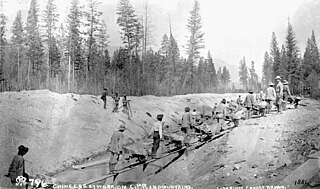
There has been a significant history of Chinese immigration to Canada, with the first settlement of Chinese people in Canada being in the 178://www.thecanadianencyclopedia.ca/en/article/chinese-canadians |date=27 November 2020 }}." The Canadian Encyclopedia. Ottawa: Historica Canada. Retrieved 2020 December 14.</ref> The major periods of Chinese immigration would take place from 1858 to 1923 and 1947 to the present day, reflecting changes in the Canadian government's immigration policy.

Chinese Canadians are Canadians of full or partial Chinese ancestry, which includes both naturalized Chinese immigrants and Canadian-born Chinese. They comprise a subgroup of East Asian Canadians which is a further subgroup of Asian Canadians. Demographic research tends to include immigrants from Mainland China, Taiwan, Hong Kong, and Macau, as well as overseas Chinese who have immigrated from Southeast Asia and South America into the broadly defined Chinese Canadian category.

Chinatown is a neighbourhood in Vancouver, British Columbia, and is Canada's largest Chinatown. Centered around Pender Street, it is surrounded by Gastown to the north, the Downtown financial and central business districts to the west, the Georgia Viaduct and the False Creek inlet to the south, the Downtown Eastside and the remnant of old Japantown to the northeast, and the residential neighbourhood of Strathcona to the southeast.
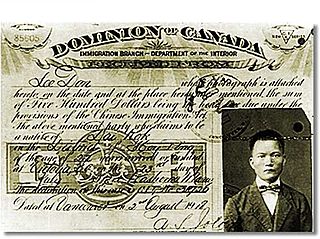
The Chinese Head Tax was a fixed fee charged to each Chinese person entering Canada. The head tax was first levied after the Canadian parliament passed the Chinese Immigration Act of 1885 and it was meant to discourage Chinese people from entering Canada after the completion of the Canadian Pacific Railway (CPR). The tax was abolished by the Chinese Immigration Act of 1923, which outright prevented all Chinese immigration except for that of business people, clergy, educators, students, and some others.
The Chinese Immigration Act, 1923, known today as the Chinese Exclusion Act, was an act passed by the Parliament of Canada, banning most forms of Chinese immigration to Canada. Immigration from most countries was controlled or restricted in some way, but only the Chinese were completely prohibited from immigrating to Canada.
The Asiatic Exclusion League was an organization formed in the early 20th century in the United States and Canada that aimed to prevent immigration of people of Asian origin.
The Chinese Immigration Act of 1885 was a Canadian Act of Parliament that placed a head tax of $50 on all Chinese immigrants entering Canada. It was based on the recommendations published in the Royal Commission on Chinese Immigration in 1885. Assented on 20 July 1885, the intention of the Act was stated explicitly in its heading: "to restrict and regulate Chinese immigration into Canada." It followed the U.S. Chinese Exclusion Act, which was passed in 1882.
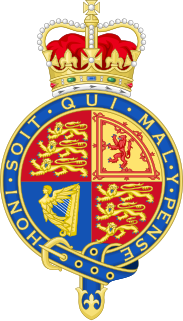
Cunningham v Homma, is a decision of the Judicial Committee of the Privy Council that upheld a British Columbia law that prohibited Japanese Canadians and Chinese Canadians from voting.

Post-Confederation Canada (1867–1914) is history of Canada from the formation of the Dominion to the outbreak of World War I in 1914. Canada had a population of 3.5 million, residing in the large expanse from Cape Breton to just beyond the Great Lakes, usually within a hundred miles or so of the Canada–United States border. One in three Canadians was French, and about 100,000 were aboriginal. It was a rural country composed of small farms. With a population of 115,000, Montreal was the largest city, followed by Toronto and Quebec at about 60,000. Pigs roamed the muddy streets of Ottawa, the small new national capital.
Anti-Chinese legislation in the United States was introduced in the United States to deal with Chinese migrants following the gold rush in California and those coming to build the railway, including:
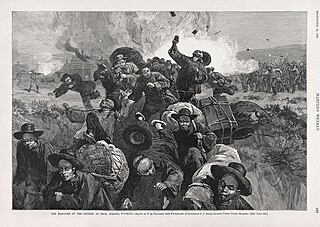
The Rock Springs massacre, also known as the Rock Springs riot, occurred on September 2, 1885, in the present-day United States city of Rock Springs in Sweetwater County, Wyoming. The riot, and resulting massacre of immigrant Chinese miners by white immigrant miners, was the result of racial prejudice toward the Chinese miners, who were perceived to be taking jobs from the white miners. The Union Pacific Coal Department found it economically beneficial to give preference in hiring to Chinese miners, who were willing to work for lower wages than their white counterparts, angering the white miners. When the rioting ended, at least 28 Chinese miners were dead and 15 were injured. Rioters burned 78 Chinese homes, resulting in approximately US$150,000 in property damage.
The Tacoma riot of 1885, also known as the 1885 Chinese expulsion from Tacoma, involved the forceful expulsion of the Chinese population from Tacoma, Washington Territory, on November 3, 1885. City leaders had earlier proposed a November 1 deadline for the Chinese population to leave the city. On November 3, 1885, a mob that consisted of prominent businessmen, police, and political leaders descended on the Chinese community. The mob marched Chinese residents to a railroad station and forced them to board a train to Portland. In the following days, the structures that remained in the Chinese community were razed. The event was the result of growing anti-Chinese sentiment and violence throughout the American West.
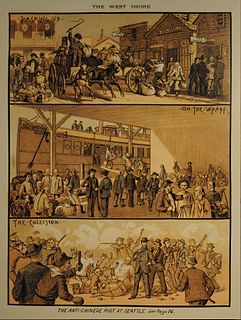
The Seattle riot of 1886 occurred on February 6–9, 1886, in Seattle, Washington, amidst rising anti-Chinese sentiment caused by intense labor competition and in the context of an ongoing struggle between labor and capital in the Western United States. The dispute arose when a mob affiliated with a local Knights of Labor chapter formed small committees to carry out a forcible expulsion of all Chinese from the city. Violence erupted between the Knights of Labor rioters and federal troops ordered in by President Grover Cleveland. The incident resulted in the removal of over 200 Chinese civilians from Seattle and left two militia men and three rioters seriously injured.
There were at least several incidents of anti-Chinese violence in Washington, a United States territory and later, a U.S. state, which occurred during the 19th, 20th and 21st century. In the 19th century, the Chinese Exclusion Act of 1882 created hostile attitudes towards the Chinese people residing in the U.S. The act sparked a wave of anti-Chinese riots and murders occurring in Washington, such as the Tacoma Riot of 1885, the Rock Springs massacre and the Hells Canyon massacre in 1887. There were riots and mob actions in Issaquah and Seattle which resulted in at least four people being killed and extensive property damage. Anti-Chinese violence continued throughout the 20th and 21st centuries, particularly in the wake of the COVID-19 pandemic.
The Chinese Benevolent Association of Vancouver is a Chinese Canadian organization headquartered in Vancouver. As of 2006 it has 2,000 members and serves as a federation of various Vancouver-based Chinese organizations. Douglas Aitken of The Georgia Straight stated that the CBA was the most important organization operating in the Vancouver Chinatown in the first half of the 20th century. The Vancouver Sun wrote "They were, for all intents and purposes, the government of Chinatown."

Racism in Canada traces both historical and contemporary racist community attitudes, as well as governmental negligence and political non-compliance with United Nations human rights standards and incidents in Canada. Contemporary Canada is the product of indigenous First Nations combined with multiple waves of immigration, predominantly from Europe and in contemporary times, from Asia.
The Pacific Coast race riots were a series of riots that took place within the United States and Canada. The riots, which resulted in violence, were the result of anti-Asian tension caused by white opposition to the increasing Asian population during the late 19th and early 20th centuries. The riots took place in San Francisco, California; Bellingham, Washington; and Vancouver, Canada. Each city and anti-Asian activist group held its own unique reasoning for their specific riot. The target of hatred in Bellingham was several hundred Sikh workers who had recently immigrated from India. Vancouver attacked Chinese. San Francisco attacked Japanese.

The Vancouver riots occurred September 7–9, 1907, in Vancouver, British Columbia, Canada. At about the same time there were similar anti-Asian riots in San Francisco, Bellingham, Washington, and other West Coast cities. They were not coordinated, but instead reflected common underlying anti-immigration attitudes. Agitation for direct action was led by labour unions and small business. No one was killed but the damage to Asian-owned property was extensive. One result was an informal agreement whereby the government of China stopped emigration to Canada.
The history of Chinese Canadians in British Columbia began with the first recorded visit by Chinese people to North America in 1788. Some 30–40 men were employed as shipwrights at Nootka Sound in what is now British Columbia, to build the first European-type vessel in the Pacific Northwest, named the North West America. Large-scale immigration of Chinese began seventy years later with the advent of the Fraser Canyon Gold Rush of 1858. During the gold rush, settlements of Chinese grew in Victoria and New Westminster and the "capital of the Cariboo" Barkerville and numerous other towns, as well as throughout the colony's interior, where many communities were dominantly Chinese. In the 1880s, Chinese labour was contracted to build the Canadian Pacific Railway. Following this, many Chinese began to move eastward, establishing Chinatowns in several of the larger Canadian cities.

East Asian Canadians are Canadians who were either born in or can trace their ancestry to East Asia. The term East Asian Canadian is a subgroup of Asian Canadians. According to Statistics Canada, East Asian Canadians are considered visible minorities and can be further divided by ethnicity and/or nationality, such as Chinese Canadian, Hong Kong Canadian, Japanese Canadian, Korean Canadian, Mongolian Canadian, Taiwanese Canadian or Tibetan Canadian, as seen on demi-decadal census data.